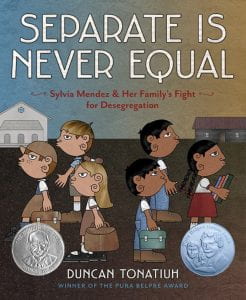 Almost 10 years before Brown v. Board of Education, Sylvia Mendez and her parents helped end school segregation in California. Mendez, an American citizen of Mexican and Puerto Rican heritage, was denied enrollment to a “whites only” school. Her parents took action by organizing the Latinx community and filing a lawsuit in federal district court. Their success eventually brought an end to the era of segregated education in California. Ages 6–9.
Almost 10 years before Brown v. Board of Education, Sylvia Mendez and her parents helped end school segregation in California. Mendez, an American citizen of Mexican and Puerto Rican heritage, was denied enrollment to a “whites only” school. Her parents took action by organizing the Latinx community and filing a lawsuit in federal district court. Their success eventually brought an end to the era of segregated education in California. Ages 6–9.
About The Author
 Duncan Tonatiuh (toh-nah-tee-YOU) is the author-illustrator of The Princess and the Warrior, Funny Bones, Separate Is Never Equal, Pancho Rabbit and the Coyote, Diego Rivera: His World and Ours and Dear Primo. He is the illustrator of Esquivel! and Salsa. His books have received multiple accolades, among them the Pura Belpré Medal, the Sibert Medal, The Tomás Rivera MexicanAmerican Children’s Book Award, The Américas Award, the Jane Addams Children’s Book Award and the New York Times Best Illustrated Children’s Book Award. Duncan Tonatiuh is both Mexican and American. He grew up in San Miguel de Allende, Mexico and graduated from Parsons School of Design in New York City. His artwork is inspired by Pre-Columbian art, particularly that of the Mixtec codex.
Duncan Tonatiuh (toh-nah-tee-YOU) is the author-illustrator of The Princess and the Warrior, Funny Bones, Separate Is Never Equal, Pancho Rabbit and the Coyote, Diego Rivera: His World and Ours and Dear Primo. He is the illustrator of Esquivel! and Salsa. His books have received multiple accolades, among them the Pura Belpré Medal, the Sibert Medal, The Tomás Rivera MexicanAmerican Children’s Book Award, The Américas Award, the Jane Addams Children’s Book Award and the New York Times Best Illustrated Children’s Book Award. Duncan Tonatiuh is both Mexican and American. He grew up in San Miguel de Allende, Mexico and graduated from Parsons School of Design in New York City. His artwork is inspired by Pre-Columbian art, particularly that of the Mixtec codex.
Read Aloud Tips
- Use Language Walls to define segregation and the phrase “separate is never equal.” In small or large groups, have students discuss what
- In small or large groups, have students discuss what they know about segregation.
- Go though the pictures of the book and ask students to note things that may refer to the phrase, “separate but not equal”.
- Use debate centers to have students discuss segregation and why it is harmful.
- Ask students to reflect on what they would do if their school implemented segregation.
“Tonatiuh masterfully combines text and folkinspired art to add an important piece to the mosaic of U.S. civil rights history. The universality of parents’ desires for better opportunities for their children is made plain. The extensive author’s note provides context, and readers can connect with the real people in the story through photographs of Sylvia, her parents and the schools in question. Helpful backmatter includes a glossary, bibliography and index. Even the sourcing of dialogue is explained. A compelling story told with impeccable care.” – Kirkus Reviews